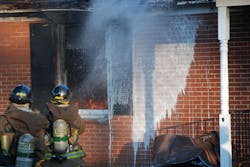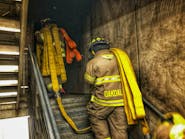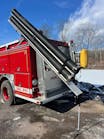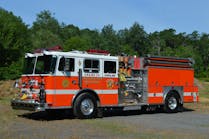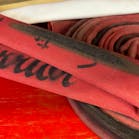Adding a Punch to Fire Attack: Enhanced Water Streams
Imagine water on steroids. That’s what Enhanced Water Streams (EWS) are like. Achieved by placing an additive into the water that we use to extinguish fire, EWS is basically water with a concentrate added into it. It can also have an enhanced delivery system, such as:
- Class A Foams
- Concentrates
- Compressed Air Foam Systems (CAFS), which is a delivery system that utilizes a concentrate in addition to air to make the finished foam.
It's important to note that even though a concentrate has been added to the water, the water is still doing the work to extinguish the fire. When water absorbs the heat, it takes away one of the three essential sides of the fire triangle, thus stopping a combustion reaction.
As we push into the structure with an aggressive interior attack, we also condition the environment using the concentrate mixed with water to prevent rapid fire progression around us.
What Is Conditioning & Why Is It Important?
Every surface around us will absorb the energy or products of combustion until they are saturated with heat. After those areas are saturated, the products will move naturally towards an area with a lower temperature. If we condition or spray a surface with enhanced water, it will soften the environment and buy us some time to properly extinguish the fire.
"We don't put water on smoke," or "A good nozzle firefighter will use the least amount of water," are some of the things you and I were taught, but this couldn't be further from the truth.
Improved Efficiency in Firefighting
With enhanced water, we actually use a significantly lesser amount of water and while conditioning the environment too. Conditioning allows us to make it easier for anyone that may be inside. There are many that object to this, due to the possibility of injury to victims from the steam, but the concept of steaming someone to death is not realistic. Human skin is destroyed at 160 degrees Fahrenheit.
In an environment well above this temperature, the proper use of the conditioning tactic will cool the environment, produce less steam and improve visibility for firefighters as well as those who may be trapped inside. Kill The Flashover Project has numerous real-world fire tests where there was a rapid improvement in visibility after a fire was extinguished.
Our fire victims are not dying in saunas; they are dying due to smoke inhalation and/or thermal insult. Proper application of this tactic can and will make a difference in life safety and our suppression efforts.
Implication of EWS to Delivery Systems
The use of a concentrate or additive in the modern fire behavior environment provides the firefighter with added protection. For example, when a hose crew advances down a hallway towards the fire room, they would condition or wet the walls, ceilings and floors with the enhanced water stream. As the chemical properties of enhanced water allow it to hang around longer than water alone, an area of refuge is created behind and around us as we move into any IDLH environment.
Fuels
By adding a concentrate to the water, it allows the water to stay on the fuel it contacts longer than water alone. It is a known fact that solid Class B fuels don’t like water. These are exactly the type of fuels that are burning in our typical residential structure fires.
Hydrophobic
Hydrophobic fuels are those that have a natural ability to repel water, like Class B fuels. The concentrate contains surfactants that, when added to water, allow the water to work more efficiently. Surfactants are defined as a substance that tends to reduce the surface tension of a liquid in which it is dissolved. Detergents and soaps contain surfactants thus creating a bond that helps the water to be better absorbed by the fuels.
Hydrophilic
Unlike hydrophobic fuels, hydrophilic fuels like water. This simply means that the fuels will grab the water with the added surfactant and hold onto it.
Seasoned Wood vs. Wet Wood
An example of the differences in how these fuels will burn can be described using a comparison between seasoned dry wood and wood that is wet. The seasoned wood will absorb thermal energy quicker and release its energy more efficiently, while the wet wood will take some time to complete the flaming combustion process because it can’t achieve all parts of the fire triangle. While fuel and oxygen are present, the heat required to sustain combustion is interrupted or slowed down significantly, thus requiring a longer time to burn.
Food For Thought
Furnishings need to be thought of as exposures within the structure. Pre-conditioning the exposures will create more time for firefighters operating within and control the heat release rate. If we view the furnishings and the adjacent rooms yet to be affected by the fire as exposures, we can begin to understand the importance of conditioning them to prevent further damage or injury. To quote a wise old fire chief:
"Remember, everything will dry out, but nothing un-burns." - Fire Chief Buddy Wilson
Benefits of EWS
To sum it up, here are the benefits of using Enhanced Water Streams.
- Less time overhauling during and after a fire, prolonging our crews’ effectiveness.
- Less area to absorb heat, thus keeping our crews safer from thermal insult
- Improved visibility
- Less wear and tear on the apparatus, as utilizing EWS will reduce the time our engines are pumping/flowing water
- Less water used, which means less damage to property, which is one of our fire service priorities that has been receiving less attention due to manpower issues
There are a few NFPA standards that specifically outline the use of agents:
- NFPA 18: Standard on wetting agents (most in-depth standard)
- NFPA 1150: Standard on Foam Chemicals for Fires in Class A Fuels
- NFPA 11: Standard for Low, Medium, and High Expansion Foam (for Class B Fuels)
JOHN DIXON is a career fire officer with an urban fire department in New Jersey and has over 19 years in the fire service. He is a certified Instructor II and Fire Officer III. Dixon has a passion for the fire service and for training, mentoring and inspiring up-and-coming firefighters and officers. He also serves as an Instructor with the Bergen County, N.J., Fire Academy. You can contact him through his website: InstructorJohnDixon.com.
